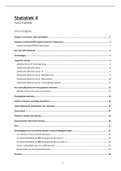Notes de cours
Samenvatting statistiek 4 (NEDERLANDS) ()
- Cours
- Statistiek IV (P0P74A)
- Établissement
- Katholieke Universiteit Leuven (KU Leuven)
Alle te kennen leerstof (eigen nota's en slides) zijn verwerkt in 1 document, in het NEDERLANDS. Deze samenvatting omvat hoofdstuk 1- 13 met tabellen/ grafieken/ tekeningen (behalve hoofdstuk 12, niet te kennen). Alle Engelse slides zijn vertaald naar het Nederlands en gebundeld in 1 document.
[Montrer plus]



